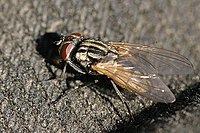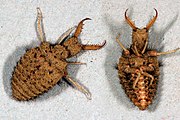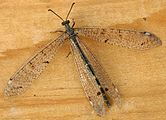AY Honors/Insects - Advanced/Answer Key
1. Have the Insects Honor.
2.Do one of the following:
a. Add to your collection 50 species of insects representing at least ten different orders. Labels must include collector's name, date, locality, order, family, and genus or species level name. (Carelessly mounted or broken specimens are not acceptable.)
b. Add to your colored drawings or paintings 50 species of insects, representing at least ten different orders. Drawings or paintings need to be life size or larger, to show the details of small insects, and in natural coloring. Label drawings with date, order, family, and genus or species level name.
c. Add to your colored photographs 50 species of insects, representing at least ten different orders. All pictures are to be in focus, close-ups and properly labeled, showing where photographed, the date photographed, and order, family, and genus or species level name.
There are several insects described in the Insects honor, though not nearly enough (currently) to satisfy this requirement. We recommend that you obtain a Field Guide to the insects common to your area. As with any nature identification task, the better approach is to find the insects first, and then identify them. This works far better than deciding which insects you want to find and then going out to look for them.
3. How do the special structures and habits of insects fit them so admirably for life?
Insects possess segmented bodies supported by an exoskeleton, a hard outer covering made mostly of chitin. The segments of the body are organized into three distinctive but interconnected units; a head, a thorax, and an abdomen. The head supports a pair of sensory antennae, a pair of compound eyes, one to three simple eyes and three sets of variously modified appendages that form the mouthparts. The thorax has six segmented legs and two or four wings (if present in the species). The abdomen has most of the digestive, respiratory, excretory and reproductive internal structures.
Many insects possess very sensitive and/or specialized organs of perception. Some insects such as bees can perceive ultraviolet wavelengths, or detect polarized light, while the antennae of male moths can detect the pheromones of female moths over distances of many kilometers.
Most insects lead short lives as adults, and rarely interact with one another except to mate, or compete for mates. A small number exhibit some form of parental care, where they will at least guard their eggs, and sometimes continue guarding their offspring until adulthood, and possibly even actively feeding them. Another simple form of parental care is to construct a nest (a burrow or an actual construction, either of which may be simple or complex), store provisions in it, and lay an egg upon those provisions. The adult does not contact the growing offspring, but it nonetheless does provide food.
4. Explain the life cycle of four insects in four different families.
Bees
Eggs are laid singly in a cell in a wax honeycomb, produced and shaped by the worker bees. Larvae are initially fed with royal jelly produced by worker bees, later switching to honey and pollen. The exception is a larva fed solely on royal jelly, which will develop into a queen bee. The larva undergoes several moltings before spinning a cocoon within the cell, and pupating. Drones hatch from unfertilized eggs, females (Queens and worker bees) hatch from fertilized eggs. The queen actually can choose to fertilize the egg she is laying, usually depending on what cell she is laying in.
Young worker bees clean the hive and feed the larvae. When their royal jelly producing glands begin to atrophy, they begin building comb cells. They progress to other within-colony tasks as they become older, such as receiving nectar and pollen from foragers, and guarding the hive. Later still, a worker takes her first orientation flights and finally leaves the hive and typically spends the remainder of its life as a forager.
Worker bees cooperate to find food and use a pattern of "dancing" (known as the bee dance or waggle dance) to communicate information regarding resources with each other; this dance varies from species to species, but all living species of Apis exhibit some form of the behavior. If the resources are very close to the hive, they may also exhibit a less specific dance commonly known as the "Round Dance".
Honey bees also perform tremble dances which recruit receiver bees to collect nectar from returning foragers .
Virgin queens go on mating flights away from their home colony, and mate with multiple drones before returning. The drones die in the act of mating.
Colonies are established not by solitary queens, as in most bees, but by groups known as "swarms", which consist of a mated queen and a large contingent of worker bees. This group moves en masse to a nest site that has been scouted by worker bees beforehand. Once they arrive, they immediately construct a new wax comb and begin to raise new worker brood. This type of nest founding is not seen in any other living bee genus, though there are several groups of Vespid wasps which also found new nests via swarming (sometimes including multiple queens). Also, stingless bees will start new nests with large numbers of worker bees, but the nest is constructed before a queen is escorted to the site, and this worker force is not a true "swarm".
Housefly
Each female fly can lay over 9,000 eggs. The eggs are white and are about 1.2 mm in length. Within a day, larvae (maggots) hatch from the eggs; they live and feed in (usually dead and decaying) organic material, such as garbage or feces. They are pale-whitish, 3-9 mm long, thinner at the mouth end, and have no legs. They live at least one week. At the end of their third instar, the maggots crawl to a dry cool place and transform into pupae, colored reddish or brown and about 8 mm long. The adult flies then emerge from the pupae. (This whole cycle is known as complete metamorphosis.) The adults live from half a month to a month in the wild, or longer in benign laboratory conditions. After having emerged from the pupae, the flies cease to grow; small flies are not young flies, but are indeed the result of getting insufficient food during the larval stage.
Some 36 hours after having emerged from the pupa, the female is receptive for mating. The male mounts her from behind to inject sperm. Normally the female mates only once, storing the sperm to use it repeatedly for laying several sets of eggs.
Monarch Butterfly
The life cycle of a monarch includes a change of form called complete metamorphosis. The monarch goes through four radically different stages:
- The eggs are laid by the females during spring and summer breeding months.
- The eggs hatch, revealing worm-like larvae, the caterpillars. The caterpillars consume their egg cases, then feed on milkweed. During the caterpillar stage, monarchs store energy in the form of fat and nutrients to carry them through the non-feeding pupa stage.
- In the pupa or chrysalis stage, the caterpillar spins a silk pad on a twig, leaf, etc., and hangs from this pad by its last pair of prolegs. It hangs upside down in the shape of a 'J', and then molts, leaving itself encased in an articulated green exoskeleton. At this point, hormonal changes occur, leading to the development of a butterfly (metamorphosis). The chrysalis darkens (actually becomes transparent) a day before it emerges, and its orange and black wings can be seen.
- The mature butterfly emerges after about two pupal weeks and hangs from the split chrysalis for several hours until its wings are dry (often in the morning). Meanwhile fluids are pumped into the crinkled wings until they become full and stiff. Some of this orangey fluid (called meconium) drips from the wings. Finally (usually in the afternoon) the monarch spreads its wings, quivers them to be sure they are stiff, and then flies away, to feed on a variety of flowers, including milkweed flowers, red clover, and goldenrod.
Antlion
The life cycle of the antlion begins with oviposition (egg-laying). The female antlion repeatedly taps the sand surface with the tip of her abdomen. She then inserts her abdomen into the sand and lays an egg. The antlion larva is a ferocious-appearing creature with a robust, fusiform body, a very plump abdomen, the thorax bearing three pairs of walking legs. The prothorax forms a slender mobile "neck" for the large, square, flattened head, which bears an enormous pair of sicklelike jaws with several sharp, hollow projections. The jaws are formed by the maxillae and mandibles, which in each pincer enclose a canal for injecting venom between them. Depending on species and where it lives, the larvae will either hide under leaves or pieces of wood, in cracks of rocks, or dig pits in sandy areas.
The pupal stage of the antlion is quiescent. The larva makes a globular cocoon of sand stuck together with fine silk spun from a slender spinneret at the posterior end of the body. These cocoons may be buried several centimeters deep in the sand. It remains there for one month, until the completion of the transformation into the sexually mature insect, which then emerges from the case, leaving the pupal integument behind, and climbs to the surface. After about 20 minutes the adult's wings are fully opened and it will fly off in search of a mate. The adult is considerably larger than the larva; they exhibit the greatest disparity in size between larva and adult of any type of holometabolous insects, by virtue of the adults having an extremely thin, flimsy exoskeleton - in other words, they have extremely low mass per unit of volume.
5. Name two kinds of social insects. How do they differ from nonsocial insects?
Social insects, such as the termites, ants and many bees and wasps, live together in large well-organized colonies that may be so tightly integrated and genetically similar that the colonies of some species are sometimes considered superorganisms.
The term eusocial was originally defined to include those organisms (originally, only invertebrates) that had certain features:
- Reproductive division of labor (with or without sterile castes)
- Overlapping generations
- Cooperative care of young
The most familiar examples are insects such as ants, bees, and wasps (order Hymenoptera), as well as termites (order Isoptera), all with reproductive queens and more or less sterile workers and/or soldiers.
6. Name at least four insects that carry disease to man. Name at least one disease carried by each.
| Mosquito | Flea | Louse | Housefly | Tsetse fly |
|---|---|---|---|---|
|
|
|
|
|
7. Make one of the following:
a. Aerial net
b. Sweeping net
c. Aquatic net
- http://hometown.aol.com/xerantheum/insects.html
- http://www.sas.org/E-Bulletin/2001-12-07/labNotes2/labNotes.html
8. Construct and use a trap for night-flying insects.
An easy way to trap night-flying insects is to suspend a white bedsheet vertically next to a light bulb. Be careful that the bulb does not touch the sheet, as this would be a fire hazard. If possible, use a light bulb that emits ultra-violet light (but be careful to not look at the lit bulb as it can cause eye damage). The insects will be attracted to the light and land on the sheet. They can be picked off by hand.
You can also suspend a light bulb over a pan filled with water and a few drops of dish soap. The dish soap breaks the surface tension on the water so that the insects sink and drown (rather than walking on the surface). Such a trap can be left overnight.



